1997 PONTIAC BONNEVILLE check engine
[x] Cancel search: check enginePage 71 of 405
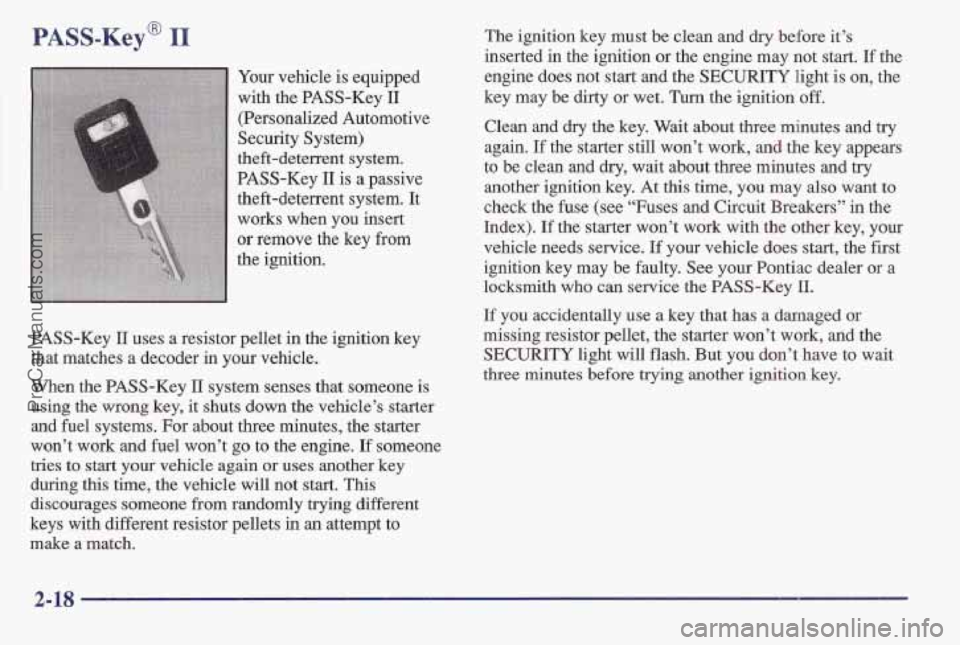
PASS-K~~~ 11
Your vehicle is equipped
with the PASS-Key
11
(Person’alized Automotive
Security System)
theft-deterrent system.
PASS-Key
11 is a passive
theft-deterrent system. It
works when
you insert
or remove the key from
the ignition.
PASS-Key
I1 uses a resistor pellet in the ignition key
that matches a decoder
in your vehicle.
When the PASS-Key
I1 system senses that someone is
using
the wrong key, it shuts down the vehicle’s starter
and fuel systems. For about thee minutes, the starter
won’t work and fuel won’t go to the engine.
If someone
tries to start your vehicle again or uses another key
during this time, the vehicle will not start. This
discourages someone
from randomly trying different
keys with different resistor pellets in
an attempt to
make a match. The
ignition key must be clean and
dry before it’s
inserted in the ignition or the engine may not start.
If the
engine does not start and the SECURITY light is
on, the
key may be dirty or wet.
Turn the ignition off.
Clean and dry the key. Wait about three minutes and try
again. If the starter s’till won’t work, and the key appears
to be clean and dry, wait about three minutes
and try
another ignition key. At this time, you may also want to
check the fuse (see “Fuses and Circuit Breakers” in the
Index);
If the staster won’t work with the other key, your
vehicle needs service.
If your vehicle does start, the first
ignition key may be faulty. See
your Pontiac dealer or a
locksmith who can service the PASS-Key 11.
If you accidentally use a key that has a damaged or
missing resistor pellet, the starter won’t work, and the
SECURITY light will flash. But you don’t have to wait
three minutes before trying another ignition key.
2-18
ProCarManuals.com
Page 75 of 405
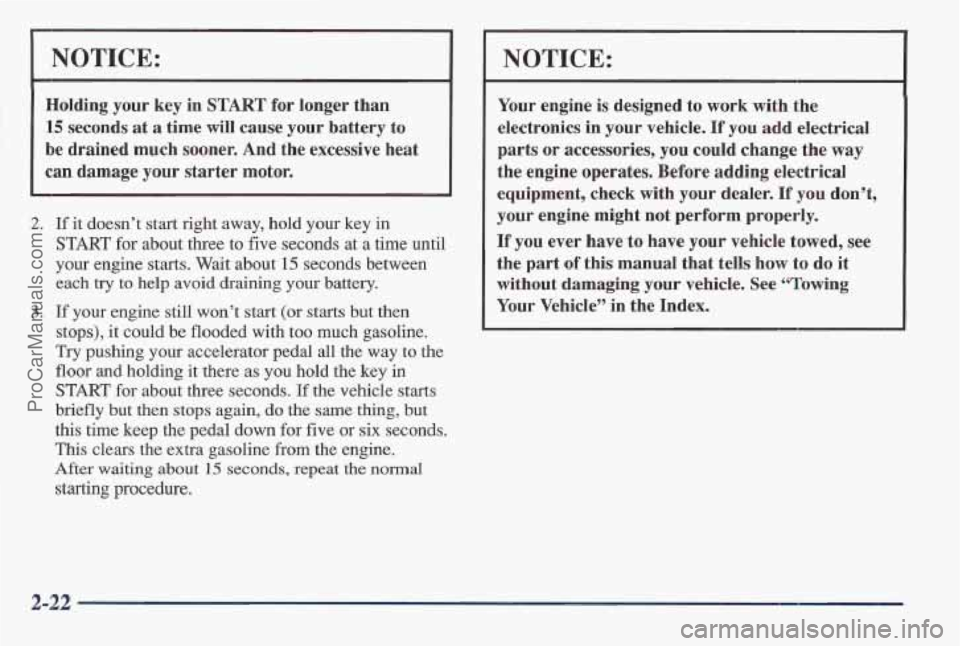
NOTICE:
Holding your key in START for longer than
15 seconds at a time will cause your battery to
be drained much sooner. And the excessive heat
can damage
your starter motor.
2. If it doesn’t start right away, hold your key in
START for about three to five seconds at a time until
your engine starts. Wait about
15 seconds between
each try to help avoid draining your battery.
3. If your engine still won’t start (or starts but then
stops), it could be flooded with too much gasoline.
Try pushing your accelerator pedal all the way to the
floor and holding
it there as you hold the key in
START for about three seconds. If the vehicle starts
briefly
but then stops again, do the same thing, but
this time keep the pedal down for five or six seconds.
This clears the extra gasoline from the engine.
After
waiting about 15 seconds, repeat the normal
starting procedure.
NOTICE:
Your engine is designed to work with the
electronics in your vehicle. If you add electrical
parts or accessories, you could change the way
the engine operates. Before adding electrical
equipment, check with your dealer.
If you don’t,
your engine might not perform properly.
If you ever have to have your vehicle towed, see
the part
of this manual that tells how to do it
without damaging your vehicle. See “Towing
Your Vehicle” in the Index.
2-22
ProCarManuals.com
Page 117 of 405
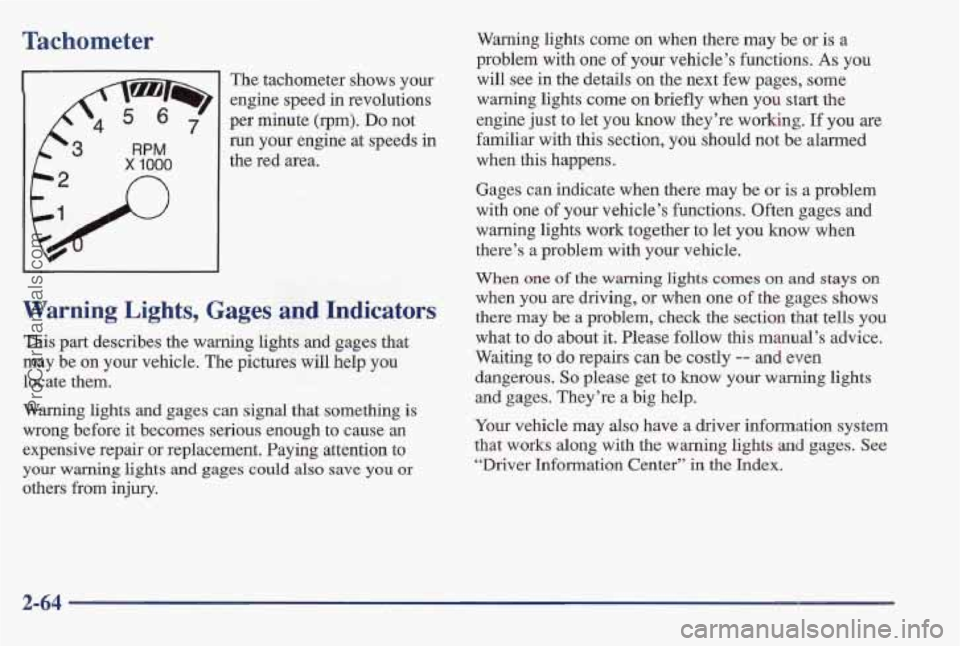
Tachometer
The tachometer shows your
engine speed in revolutions
per minute (rpm).
Do not
run your engine at speeds in
the red area.
Warning Lights, Gages and Indicators
This part describes the warning lights and gages that
may b’e on your vehicle.
The pictures will help you
locate them.
Warning lights and gages can signal that something
is
wrong before it becomes serious enough to cause an
expensive repair
or replacement. Paying attention to
your warning lights and gages could also save you or
others from injury.
Warning lights come on when there may be or is a
problem with one of your vehicle’s functions.
As you
will see in the details on the next few pages, some
warning lights
come on briefly when you start the
engine just to let you know they’re working.
If you are
familiar with this section, you should not be alarmed
when this happens.
Gages can indicate when there may be or
is a problem
with one
of your vehicle’s functions. Often gages and
warning lights work together to let you know when
there’s a problem with your vehicle.
When one of the warning lights comes on and stays on
when you are driving, or when one of the gages shows
there may be a problem, check the section that tells you
what to
do about it. Please follow this manual’s advice.
Waiting to do repairs can be costly
-- and even
dangerous.
So please get to know your warning lights
and gages. They’re a big help.
Your vehicle may also have a driver information system
that works
along with the warning lights and gages. See
“Driver Information Center” in the Index.
2-64
ProCarManuals.com
Page 118 of 405
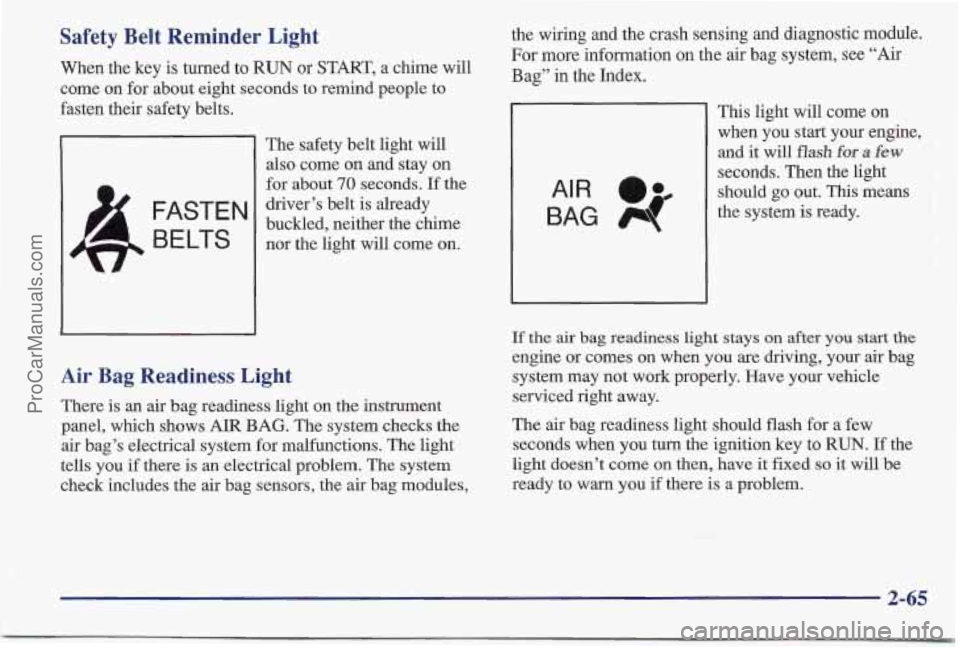
Safety Belt Reminder Light
When the key is turned to RUN or START, a chime will
come on for about eight seconds to remind people to
fasten their safety belts.
The safety belt light will
also come on and stay on
for about
70 seconds. If the
driver’s belt is already
buckled, neither the chime
B E LTS nor the light will come on.
FASTEN
Air Bag Readiness Light
There is an air bag readiness light on the instrument
panel, which shows AIR
BAG. The system checks the
air bag’s electrical system for malfunctions. The light
tells you
if there is an electrical problem. The system
check includes the air bag sensors, the air bag modules, the
wiring and the crash sensing and diagnostic module.
For more information on the air bag system, see “Air
Bag” in the Index.
This light will come on when you start your engine,
and
it will flash for a few
seconds. Then the light
should go out. This means
the system
is ready.
If the air bag readiness light stays on after you start the
engine or comes on when you are driving, your air bag
system may not work properly. Have your vehicle
serviced right away.
The air bag readiness light should flash for a few
seconds when you turn the ignition key to RUN.
If the
light doesn’t
come on then, have it fixed so it will be
ready to warn you
if there is a problem.
2-65
ProCarManuals.com
Page 119 of 405
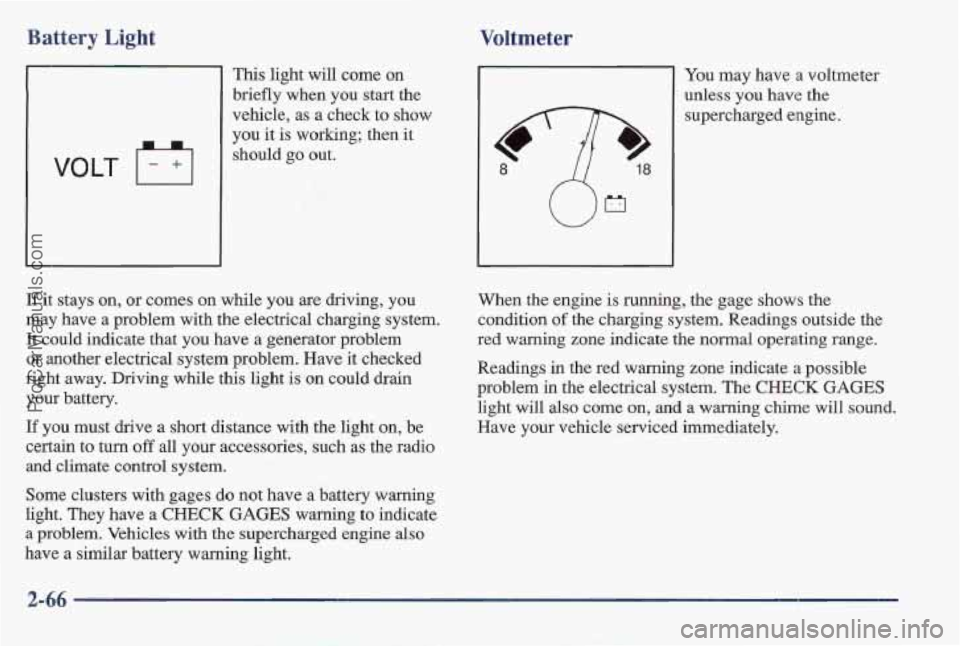
Battery Light Voltmeter
VOLT
This light will come on
briefly when you start the
vehicle, as a check to show
you it is working; then it
should go out.
You may have a voltmeter
unless you have the
supercharged engine.
If it stays on, OF comes on while you are driving, you
may have a problem with the electrical charging system.
It could indicate that you have a generator problem
or another electrical system problem. Have it checked
right away. Driving while this light is
on could drain
your battery.
If you must drive a short distance with the light on, be
certain to turn
off all your accessories, such as the radio
and climate control system.
Some clusters with gages do not have a battery warning
light. They have a
CHECK GAGES warning to indi'cate
a problem. Vehicles with th'e supercharged engine also
have
a simil'ar battery warning light. When the engine
is running, the
gage shows the
condition
of the charging system. Readings outside the
red warning zone indicate the normal operating range.
geadings
in the red warning zone Indicate a possible
problem
in the electrical system. The CHECK GAGES
light will also come on, and a warning chime will sound.
Have your vehicle serviced immediately.
2-66
ProCarManuals.com
Page 123 of 405
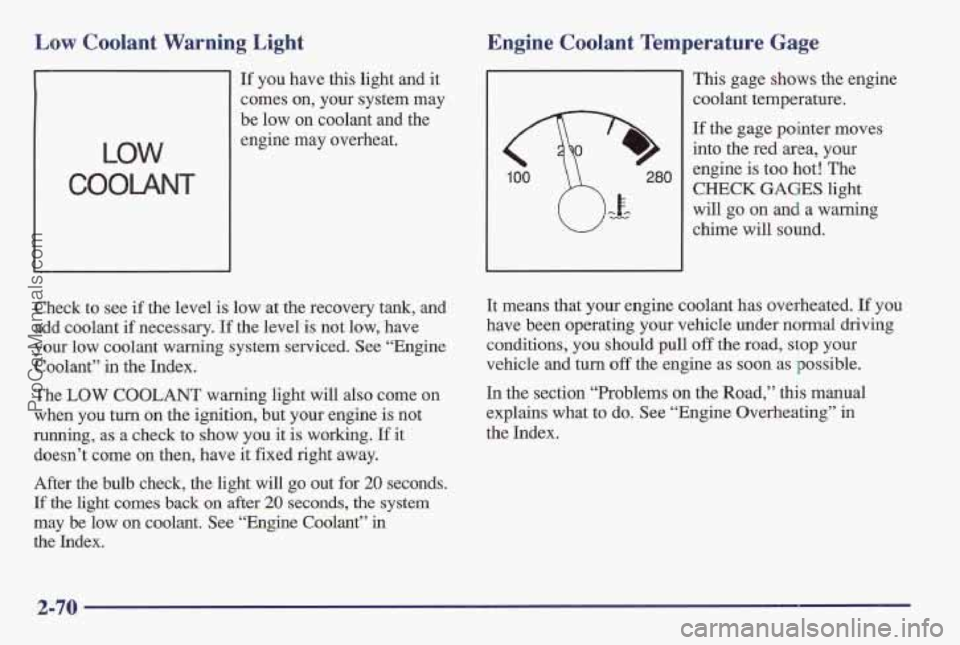
Low Coolant Warning Light
LOW
COOLANT
If you have this light and it
comes on, your system may
be low on coolant and the
engine may overheat.
Check
to see if the level is low at the recovery tank, and
add coolant
if necessary. If the level is not low, have
your low coolant
warning system serviced. See “Engine
Coolant” in the Index.
The
LOW COOLANT warning light will also come on
when you turn on the ignition, but your engine
is not
running, as a check to show you it is working. If it
doesn’t come on then, have
it fixed right away.
After the bulb check, the light will
go out for 20 seconds.
If the light comes back on after 20 s’ecoaads, the system
may be low
on coolant. See “Engine COQ~~”~II
the Index.
.. .-,.%.. - ,
Engine Coolant Temperature Gage
100 280
This gage shows the engine
coolant temperature.
If the gage pointer moves
into the red area, your
engine is too
hot! The
CHECK GAGES light
will go on and a warning
chime
will sound.
It means that your engine coolant has overheated. If you
have been operating your vehicle under normal driving
conditions, you should pull
off the road, stop your
vehicle and turn
off the engine as soon as possible.
In the section “Problems on the Road,”
this manual
explains what to do. See “Engine Overheating’’ in
the Index.
2-70
ProCarManuals.com
Page 124 of 405
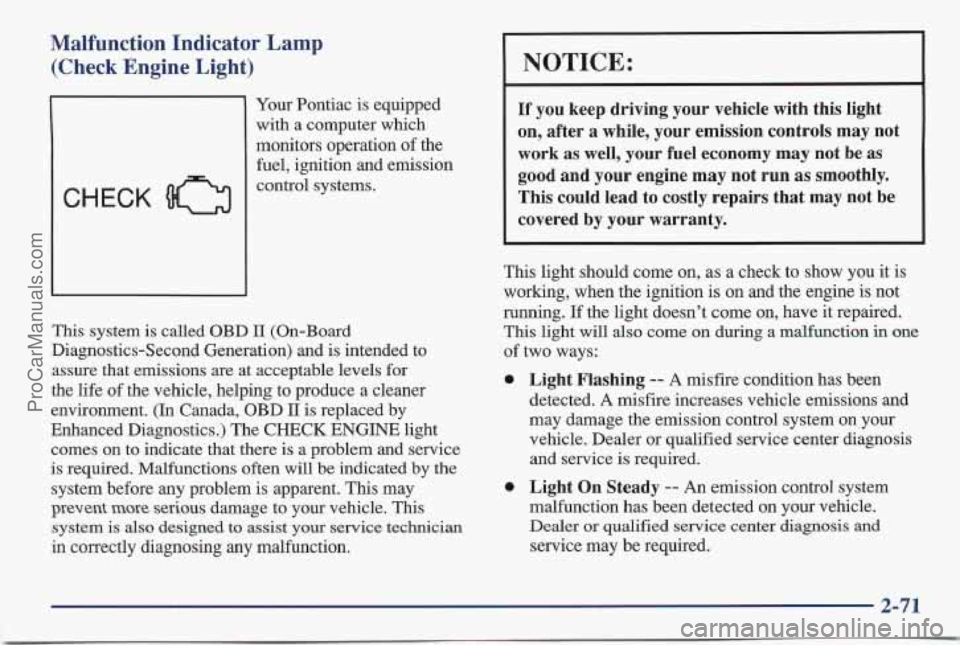
Malfunction Indicator Lamp (Check Engine Light)
CHECK
Your Pontiac is equipped
with a computer which
monitors operation
of the
fuel, ignition and emission
control systems.
This system is called OBD
I1 (On-Board
Diagnostics-Second Generation) and is intended to
assure that emissions
are at acceptable levels for
the life
of the vehicle, helping to produce a cleaner
environment. (In Canada,
OBD I1 is replaced by
Enhanced Diagnostics.) The CHECK ENGINE light
comes on to indicate that there is a problem and service
is required. Malfunctions often will be indicated by the
system before any problem is apparent. This may
prevent more serious damage to your vehicle. This
system
is also designed to assist your service technician
in correctly diagnosing any malfunction.
NOTICE:
If you keep driving your vehicle with this light
on, after a while, your emission controls may not
work as well, your fuel economy may not be
as
good and your engine may not run as smoothly.
This could lead to costly repairs that may not be covered by your warranty.
This light should come on, as a check to show you it is
working, when the ignition
is on and the engine is not
running.
If the light doesn’t come on, have it repaired.
This light will also come on during a malfunction in
one
of two ways:
0 Light Flashing -- A misfire condition has been
detected.
A misfire increases vehicle emissions and
may damage the emission control system on your
vehicle. Dealer or qualified service center diagnosis
and service is required.
0 Light On Steady -- An emission control system
malfunction has been detected on your vehicle.
Dealer or qualified
service center diagnosis and
service may be required.
2-71
ProCarManuals.com
Page 125 of 405
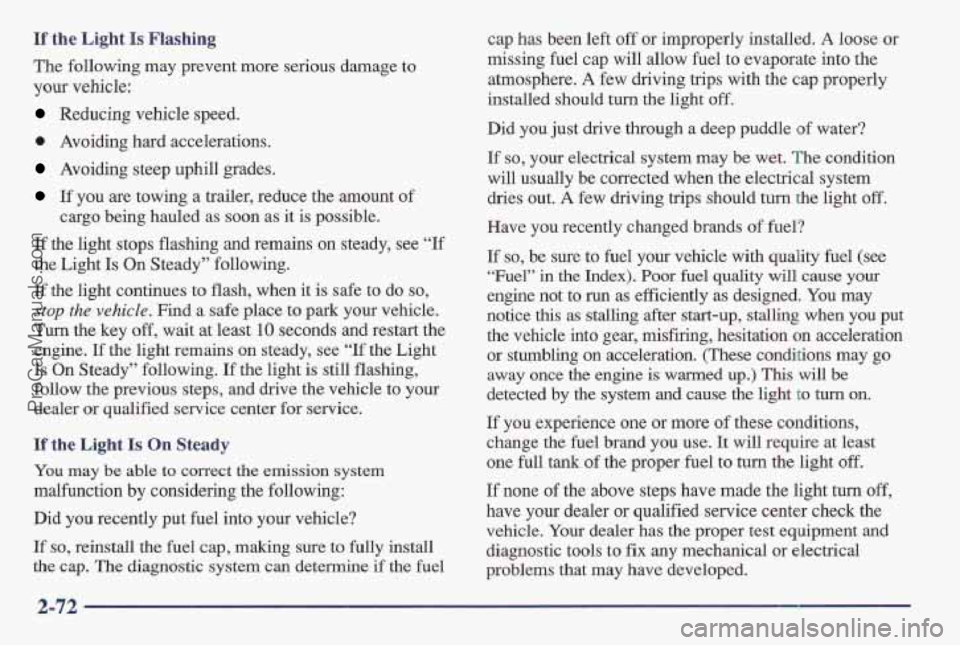
If the Light Is Flashing
The following may prevent more serious damage to
your vehicle:
Reducing vehicle speed.
0 Avoiding hard accelerations.
Avoiding steep uphill grades.
If you are towing a trailer, reduce the amount of
cargo being hauled as soon as it is possibmle.
If the light stops flashing and remains on steady, see “If
the Light
Is On Steady” following.
If the light continues to flash, when it is safe to do
so,
stop the vehicle. Find a safe place to park your vehicle.
Turn the key
off, wait at least 10 seconds and restart the
engine. If
the light remains on steady, see “If the Light
Is On Steady” following.
If the light is still flashing,
follow the previous steps, and drive the vehicle to your
dealer or qualified service center for service.
If the Light Is On Steady
You may be able to correct the emission system
malfunction
by considering the following:
Did you recently put fuel into your vehicle?
If so, reinstall the fuel cap, making sure to fully install
the cap. The diagnostic system can determine if the fuel cap
has been left
off or improperly installed. A loose or
missing fuel cap will allow fuel to evaporate into the
atmosphere.
A few driving trips with the cap properly
installed should turn the light off.
Did you just drive through
a deep puddle of water?
If
so, your electrical system may be wet. The condition
will usually be corrected when the electrical system
dries out,
A few driving trips should turn the light off.
Have
you recently changed brands of fuel?
If
so, be sure to fuel your vehicle with quality fuel (see
“Fuel”
in the Index). Poor fuel quality will cause your
engine not to run as efficiently as designed. You may
notice this as stalling after start-up, stalling when you put
the vehicle into gear, misfiring, hesitation on acceleration
or stumbling on acceleration. (These conditions may
go
away once the engine is warmed up.) This will be
detected
by the system and cause the light to hrn on.
If you experience one or more
of these conditions,
change
the fuel brand you use. It will require at least
one full tank of the proper fuel to turn the light off.
If none of the above steps have made the light turn on,
have your dealer or qualified service center check the
vehicle. Your dealer has the proper test equipment and
diagnostic tools to fix any mechanical or electrical
problems that may have developed.
2-72
ProCarManuals.com